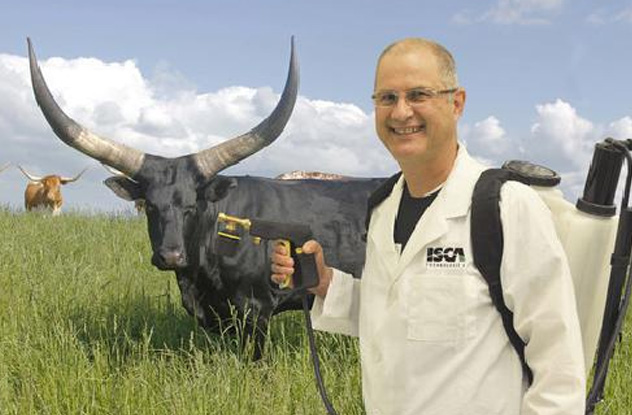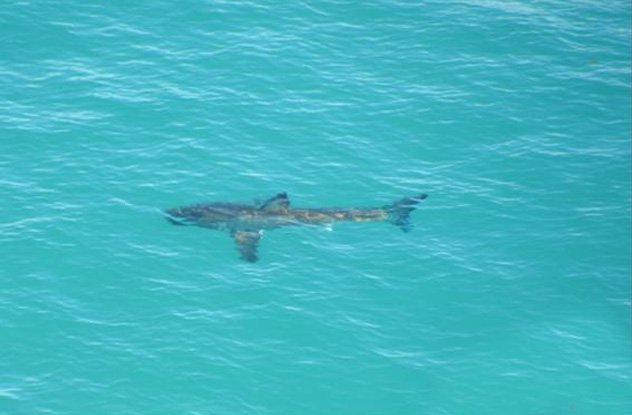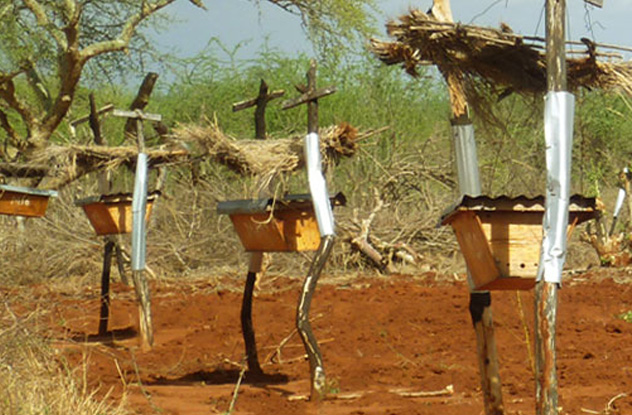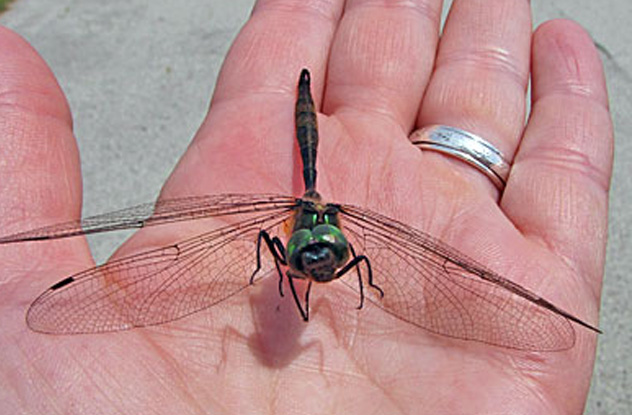10Pig Perfume For Dogs
John McGlone owned a Cairn terrier, an adorable dog that just wouldn’t shut up. Frustrated, the Texas Tech scientist retreated to his lab where he cooked up a crazy bottle of cologne that would hush puppies all over the planet. Named “Boar Mate” or “Stop That,” McGlone’s special spray included a pungent ingredient guaranteed to quiet the loudest Labradors and the rowdiest Rottweilers: pig pheromones. Known as androstenone, this particular pheromone is produced by male pigs during mating season. Discharged through fat and saliva, it lets all the sows know the male is ready. But while female pigs find it arousing, dogs think it’s disgusting. Working with a nearby canine research facility, McGlone ran a series of tests using spritz bottles full of various fluids. Some were filled with placebos, others with a low amount of androstenone, and others were brimming with the stuff. By the time he was through, McGlone discovered that all dogs shut up when sprayed in the face with pig chemicals. The spray has no adverse effects on a dog’s heart rate—it’s completely harmless, just really disorienting. While the effects only last for a minute, it’s still a better solution than a shock collar, and McGlone’s product might even save lives. The number one reason that owners send their dogs to shelters is that their pets won’t settle down. “Stop That” may put a stop to that.
9Glow-In-The-Dark Reindeer
The icy Finnish region of Lapland is home to the Rovaniemi Santa Claus Village. As you might expect, the place is crawling with reindeer. Unfortunately, most of these guys can’t fly, so when they walk across roads at night, they often end up as roadkill. Every year, 3,000–5,000 die in highway collisions. Reindeer breeders have hatched an ingenious scheme to save their livestock. In February 2014, ranchers coated 20 caribou with two kinds of paint that reflect the lights of oncoming cars. One paint is specially designed for the fur and will eventually wash away. The other is applied to the antlers and is much more permanent. If the experiment is successful, the herders will paint all their animals. Soon, Lapland might be full of ghostly blue caribou that glow in your headlights.
8The Mongoose Dilemma
Earlier in 2014, the Fort Wayne Children’s Zoo of Indiana ran into a rather perplexing problem. Their banded mongooses weren’t getting along at all. The trouble began when one of the little guys was given a routine checkup. After the vets gave Rikki a clean bill of health, the keepers put him back into his pen, and that’s when things got tense. The other mongooses gave their buddy the cold shoulder, and if he got too close, a few knocked him around. The zookeepers were completely puzzled. Just a few days before, everything had been fine. Banded mongooses are very social animals. They live in groups up to 40 mammals strong and take care of one another by standing guard and bringing back food for the group. The animals all look alike, so they identify one another by smell, and that was Rikki’s problem. When he went back to get his checkup, his scent had been altered, and now his friends didn’t know who he was. Zookeeper Nancee Hutchinson couldn’t give Rikki his old smell back, but she could do something about the rest of the troop. Hutchinson smeared Vicks VapoRub on the ground and let all the mongooses roll around in the cough medicine. When they were done, everybody smelled like menthol, and Rikki was welcomed back into the group with open paws.
7The Men In Monkey Masks
The city of New Delhi has long been under siege by rhesus macaques. Thanks to free handouts from humans hoping to win points with monkey god Hanuman, these pesky primates have made themselves at home in the capital city. They’ve taken over the Indian parliament building, broken into homes across the city, and even killed people like the deputy mayor. Totally desperate, the New Delhi government hired 38 langur monkeys to scare away the macaques. Langurs are significantly bigger than rhesus monkeys, and macaques are absolutely terrified of their bigger cousins. However, the plan didn’t exactly pan out as hoped. Animal rights activists called it inhumane—against the langurs—and the New Delhi courts agreed. The monkey army was scrapped, and the city was forced to move onto Plan B. Not quite ready to give up on the “monkey vs. monkey” concept yet, the city council did the next best thing. They hired 40 young men to dress up as langurs and chase away the macaques. Described by officials as “very talented,” these men don masks and suits, hide behind trees, and make loud monkey noises to chase the macaques away. The rhesus monkeys should take the hint and head back into the forests. If not, the city might fall back on rubber bullets, which would probably be more effective but way less comical.
6The Endangered Animal Sperm Bank
We lose 200–2,000 species every year, and Kyoto University scientists have decided to do something about it. Led by Takehito Kaneko, these researchers have developed a new way to preserve the sperm of endangered animals. Up until now, scientists used liquid nitrogen to preserve reproductive cells, storing samples at extremely cold temperatures. However, with the help of a special preservative, the Kyoto researchers have freeze-dried sperm from a chimp, a slow loris, and a giraffe. Thanks to this new technique, the sperm can be kept at just 4 degrees Celsius (39 °F), which is far warmer than usual and saves energy. Even better, if there’s a power failure, the sperm will temporarily be fine at room temperature. The folks at Kyoto have big dreams for their new freeze-dried process. You could say they’re reaching for the stars—or at least other planets, anyway. Their plan is to freeze-dry sperm from various endangered animals and to one day use these chunks of spunk to populate other worlds. They haven’t, however, figured out how to freeze-dry eggs yet.
5Human-Scented Cow Cologne
Mosquitoes aren’t just irritating little vampires that buzz around your ears and ruin your camping trip. They’re the most dangerous critters on the planet. According to the World Health Organization, 3.4 billion people around the world are at risk for malaria, and it’s all thanks to everybody’s least favorite insect. The Bill and Melinda Gates Foundation (BMGF) has put up quite a bit of cash to fund the war on malaria. The Gates-funded mosquito laser aims to zap the insects to death, and more recently, the foundation has turned its attention to a much smellier solution. Earlier in 2014, the BMGF donated $100,000 to ISCA Technologies, a pest management company that specializes in cologne for cows. Cows can’t get human malaria, so ISCA plans on developing human-scented cologne to lure mosquitoes away from people and toward our four-legged friends. The scent lasts for several months, and if you also spray the cattle with insecticide, it’ll kill any mosquito who tries to take a bite. The cows even benefit from the whole deal, as the “eau de human” will confuse other bugs who mainly feed on cattle. It’s a win-win scenario, unless you’re a mosquito.
4Sharks On Twitter
Shark attacks are incredibly rare. According to Emily Graslie, Chief Curiosity Correspondent for the Chicago Field Museum, you’re 10 times more likely to be bitten by a person in New York than you are to ever be attacked by a shark. But while the media sensationalize the danger of ending up in a deep-sea dessert, shark attacks do happen, especially near Australia, the country that leads the world in shark-bite deaths. Some people advocate culling the local shark population. But government researchers in Western Australia have come up with another solution where everybody wins, all thanks to the power of the Internet. In 2013, scientists tagged over 300 sharks with transmitters that keep track of where the fish are at all times. If a tagged shark gets within 800 meters (0.5 mi) of shore, the device sends out an alert that is immediately posted to Twitter, warning followers that danger is nearby. Of course, there are still plenty of sharks that aren’t tagged, but the Surf Life Saving Western Australia Twitter account is a brilliant use of social media. At the very least, it’ll keep your feed interesting.
3The Beehive Fence
The idea that elephants are scared of mice dates back to ancient Greece, and while pachyderms aren’t really afraid of rodents, they are downright terrified of another, even smaller creature: bees. An elephant’s skin is 2.5 centimeters (1 in) thick, but their eyes and trunks are supersensitive, so when they come across a bee hive, they take off running. And that’s great news for African farmers. Ever since the UN convention on International Trade in Endangered Species banned the sale of ivory in 1989, the number of elephants in Kenya has been steadily increasing. However, the human population has been growing as well, and Kenyan farmers and elephants are coming into serious conflict. As humans spread out into elephant territory, more and more people are finding themselves competing with the local wildlife. Hungry elephants often barge their way onto farms and gorge themselves on crops. When farmers try to chase them away, things turn deadly. Wanting to reduce the number of human-elephant casualties, researchers from Save the Elephants have turned to bees. In a beehive fence, hives hang from support poles, connected by a long rope. When an elephant trips the rope, the hives swing back and forth, unleashing a swarm of angry bees. That’s all it takes to send the elephants running for safety. Sure, it’s not much fun for any elephant that gets stung, but it’s a lot better than getting shot. And as an added bonus, the farmers earn extra income from all the honey.
2The Speed Limit Solution
Life is tough for the Hine’s emerald dragonfly. These little guys used to cover at least seven states, but thanks to factors like urban development and pesticides, these insects are today only found in Illinois, Michigan, Missouri, and Wisconsin. These endangered bugs mostly hang out in Door County, Wisconson, which isn’t really the best place for them. After they spend five years maturing in fens and fields, the dragonflies emerge in June and die in August. That just so happens to coincide with vacation season. Door County is popular for its beaches and orchards, but motorists accidentally kill over 3,000 Hine’s emerald dragonflies each year. As there are only about 13,000 of these invertebrates left, that’s a significant number. However, University of South Dakota graduate student Amber Furness has come up with a rather simple solution. Lower the speed limits. In 2012 and 2013, Furness drove through Door at various speeds, noting the number of dragonflies that splattered across her windshield. After two years of study, Furness discovered if people drive at 48 kilometers (30 mi) per hour, dragonflies just bounce off windshields and keep on flying. Door officials are considering her suggestion to lower the speed limit during the summer months. If they accept it, all those flies Furness ran into won’t have died in vain.
1The End Of All Suffering
Nature is beautiful, but it’s also quite brutal. Many of our favorite creatures spend their days biting, suffocating, and killing weaker animals. Of course, it’s only natural. Pain and death are part of our world and have been since time immemorial, but David Pearce wants to change all that forever. A British philosopher, Pearce is the author of “The Hedonistic Imperative,” an online manifesto that lays out a radical plan to end the suffering of every creature. While Pearce wants to convert mankind to veganism through the use of synthetic meat, his main concern is eliminating the planet’s predators. Either by extinction or genetic reprogramming, Pearce wants to rid our world of carnivores, from great white sharks to black widow spiders. There are two options. We can exterminate predators through methods like immunocontraception. Or, we can recondition carnivores using neurochips or genetic editing techniques that aim to give bears and snakes an appetite for salads. And herbivores won’t escape unaltered either. If we decide to rewire Earth’s animals, creatures like deer, turtles, and rabbits will need to be conditioned to trust their age-old enemies. According to Pearce, “Human and nonhuman animals are alike in an ethically critical respect. The pleasure-pain axis is universal to sentient life. No sentient being wants to be harmed—to be asphyxiated, dismembered, or eaten alive.” From Pearce’s point of view, animals are cognitively “akin to small children,” and since we wouldn’t let a snake eat a small child, we shouldn’t let one gobble up a mouse either. This British philosopher thinks that as intelligent beings with incredible technology, we have a duty to end pain and suffering for all creatures, no matter what they look like. Of course, even supposing his plan could work, it would come at a great price. It’s hard to imagine living in a world without cheetahs, cobras, or crocodiles. Personally, this writer wouldn’t want to. Nolan Moore is still battling the neighborhood cats and local raccoon population for control of the garbage cans. And he’s losing. If you want to keep up to date with Nolan’s writing, you can follow/friend him on Facebook. You can also send him an email here.
























